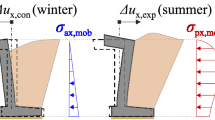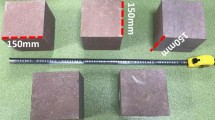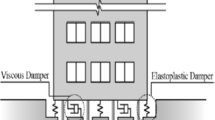Abstract
Eight full-scale energy foundations were constructed for a new building at the US Air Force Academy. The foundations are being used to demonstrate this technology to the United States Department of Defense and have several experimental features in order to study their thermal–mechanical behavior. Three of the foundations are instrumented with strain gages and thermistors, and their thermo-mechanical response during a heating and cooling test was evaluated. For a temperature increase of 18 °C, the maximum thermal axial stress ranged from 4.0 to 5.1 MPa, which is approximately 25 % of the compressive strength of concrete (estimated at 21 MPa), and the maximum upward displacement ranged from 1.4 to 1.7 mm, which should not cause angular distortions sufficient enough to cause structural or aesthetic damage of the building. The end restraint provided by the building was observed to change depending on the location of the foundation. The heat flux per meter was measured by evaluating the temperatures and flow rates of a heat exchanger fluid entering and exiting the foundations. The heat flux values were consistent with those in the literature, and the foundation with the three continuous heat exchanger loops was found to have the greatest heat flux per meter. The transient thermal conductivity of the subsurface measured using the temperatures of the subsurface surrounding the foundation ranged from 2.0 to 2.3 W/mK, which is consistent with results from thermal response tests on energy foundations reported in the literature.
















Similar content being viewed by others
References
Adam D, Markiewicz R (2009) Energy from earth-coupled structures, foundations, tunnels and sewers. Géotechnique 59(3):229–236
Amatya BL, Soga K, Bourne-Webb PJ, Amis T, Laloui L (2012) Thermo-mechanical behaviour of energy piles. Géotechnique 62(6):503–519
Bjerrum L (1963) Allowable settlement of structures. In: Proceedings of European conference on Soil Mech. and Found. Engr., Wiesbaden, Germany, vol. 3, pp 135–137
Bourne-Webb PJ, Amatya B, Soga K, Amis T, Davidson C, Payne P (2009) Energy pile test at Lambeth College, London: Geotechnical and thermodynamic aspects of pile response to heat cycles. Géotechnique 59(3):237–248
Bourne-Webb P (2013) An overview of observed thermal and thermo-mechanical response of piled energy foundations. European Geothermal Congress. Pisa, Italy. 8 p
Brandl H (2006) Energy foundations and other thermo-active ground structures. Géotechnique 56(2):81–122
Brettmann T, Amis T (2011) Thermal conductivity evaluation of a pile group using geothermal energy piles. In: Hryciw RD, Athanasopoulos-Zekkos A, Yesiller N (eds) Proc GeoCongress 2012 (GSP 225). ASCE, Reston, VA, pp 4436–4445
Energy Information Administration (EIA) (2008) Annual energy review. Report No. DOE/EIA-0384(2008)
Gao J, Zhang X, Liu J, Li K, Yang J (2008) Numerical and experimental assessment of thermal performance of vertical energy piles: an application. Appl Energy 85(10):901–910
Hamada Y, Saitoh H, Nakamura M, Kubota H, Ochifuji K (2007) Field performance of an energy pile system for space heating. Energy Build 39(5):517–524
Hernandez R (2011) Geotechnical investigation report. Construct shower/shave facility. United States Air Force Academy, Colorado. Terracon Consultants Inc, 34 p
Hughes PJ (2008) Geothermal (Ground-Source) heat pumps: market status, barriers to adoption, and actions to overcome barriers. Oak Ridge Nat. Lab. Report ORNL-2008/232
Kavanaugh S, Rafferty K, Geshwiler M (1997) Ground-source heat pumps—design of geothermal systems for commercial and industrial buildings. ASHRAE. 167 p
Knellwolf C, Peron H, Laloui L (2011) Geotechnical analysis of heat exchanger piles. J Geotech Geoenviron Eng 137(12):890–902
Laloui L, Nuth M, Vulliet L (2006) Experimental and numerical investigations of the behaviour of a heat exchanger pile. Int J Numer Anal Methods Geomechan 30:763–781
Laloui N, Nuth M (2006) Numerical modeling of some features of heat exchanger pile. Foundation Analysis and Design: Innovative Methods (GSP 153). ASCE. Reston, VA. pp 189–195
Lennon DJ, Watt E, Suckling TP (2009) Energy piles in Scotland. In: Van Impe WF, Van Impe PO (eds) Proceedings of the 5th international conference on deep foundations on bored and auger piles, Frankfurt. Taylor and Francis, London
Loveridge F, Powrie W (2012) Pile heat exchangers: thermal behaviour and interactions. Proc ICE Geotechn Eng 166(GE2):178–196
Loveridge F, Powrie W (2014) 2D thermal resistance of pile heat exchangers. Geothermics 50:122–135
McCartney JS, Murphy KD (2012) Strain distributions in full-scale energy foundations. DFI J 6(2):28–36
McCartney JS, Rosenberg JE (2011) Impact of heat exchange on the axial capacity of thermo-active foundations. In: Han J, Alzamora DE (eds) Proc. Geo-Frontiers 2011 (GSP 211). ASCE, Reston VA, pp 488–498
Mimouni T, Laloui L (2013) Towards a secure basis for the design of geothermal piles. Acta Geotechnica. doi: 10.1007/s11440-013-0245-4, 12 p
Murphy KD (2013) Evaluation of thermal and thermo-mechanical behavior of full-scale energy foundations. MS Thesis. University of Colorado Boulder, 136 p
Murphy KD, Henry K, McCartney JS (2014) Impact of horizontal run-out length on the thermal response of full-scale energy foundations. In: Abu-Farsakh M, Hoyos L (eds) Proc. GeoCongress 2014 (GSP 234). ASCE, Reston, VA, pp 2715–2724
Ooka R, Sekine K, Mutsumi Y, Yoshiro S, SuckHo H (2007) Development of a ground source heat pump system with ground heat exchanger utilizing the cast-in place concrete pile foundations of a building. EcoStock 2007. The Richard Stockton College of New Jersey, pp 1–11
Ouyang Y, Soga K, Leung YF (2011) Numerical back-analysis of energy pile test at Lambeth College, London. Geo-Frontiers 2011, Dallas, TX, pp 440–449
Sanner B (2001) Shallow geothermal energy. GHC Bulletin. June Issue, pp 19–25
Sanner B, Hellstrom G, Spitler J, Gehlin SEA (2005) Thermal response test—current status and world-wide application. World Geothermal Congress. Antalya, Turkey
Skempton AW, MacDonald DH (1956) Allowable settlement of buildings. Proceedings Institute of Civil Engineers. London, Part 3, vol 5, pp 727–768
Stewart MA, McCartney JS (2013) Centrifuge modeling of energy foundations under cyclic heating and cooling. ASCE J Geotechn Geoenviron Eng, 11 p. doi:10.1061/(ASCE)GT.1943-5606.0001061
Acknowledgments
Support from DoD ESTCP project EW-201153 is gratefully acknowledged, as are the contributions of the 819th Air Force RED HORSE Squadron, who provided support for the heating test. The views in the paper are those of the authors alone.
Author information
Authors and Affiliations
Corresponding author
Rights and permissions
About this article
Cite this article
Murphy, K.D., McCartney, J.S. & Henry, K.S. Evaluation of thermo-mechanical and thermal behavior of full-scale energy foundations. Acta Geotech. 10, 179–195 (2015). https://doi.org/10.1007/s11440-013-0298-4
Received:
Accepted:
Published:
Issue Date:
DOI: https://doi.org/10.1007/s11440-013-0298-4




